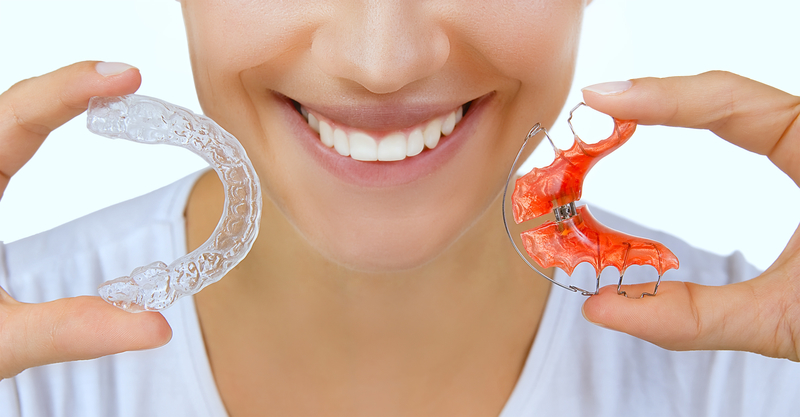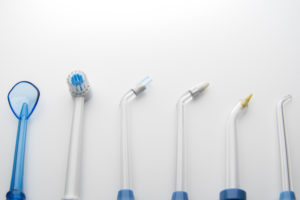Why You Should Wear Your Retainer

After you have your braces removed, most patients receive a retainer that they wear at night to keep their teeth from moving. But what kind of retainer should you have, and how long should you wear it? Retainers maintain oral health after braces by keeping your teeth in the correct alignment. Many people fail to use their retainers properly, and have to be fitted for braces again. Learn how to prevent your teeth from moving after braces and how to keep your teeth straight!
Purpose of Retainers
After you complete your time with braces, it will be necessary for you to consistently wear the retainer that your orthodontist advises you to wear. A retainer is an apparatus made of plastic and metal that is custom-made for each patient’s teeth and mouth. No two retainers are alike, but they all serve the same function as they seek to keep our teeth aligned properly after our braces are removed. Most people have to wear a retainer after they get their braces off, but many times people wear retainers to close gaps in their teeth, help with a speech impediment, or address specific medical issues. Retainers are especially important after your braces are removed, though, because our teeth will attempt to return to their original position after treatment. Another type of tooth movement that we want to avoid is natural physiological drift, which happens as the width of our smiles gets narrower as we age and our teeth begin to crowd. This occurs to everyone, but consistently using a retainer can prevent this shift in our teeth.
Getting your braces removed is definitely an exciting moment, but keeping your teeth straight is a lifetime effort. Our newly-aligned teeth need time to settle into our soft tissue and jawbone, and wearing your retainer helps this process be successful. Wearing your retainer at night and in between meals allows your teeth to hold their new form and prevents them from shifting back into their old position. As our bodies grow, our teeth follow suit, and retainers maintain the new tooth position that your braces achieved during your treatment. At the beginning, it may be necessary to wear your retainer all day for a few months, or you may only have to wear it at night a few times a week. Your orthodontist will advise you on how long and how often you should wear your retainer, and it is important that you follow all recommendations that you are given.
Types of Retainers
There are two main types of retainers that are used: removable and fixed. Removable retainers can be removed whenever you eat and brush your teeth, but typically must be worn full-time for at least one year after you get your braces removed. Hawley retainers are the most common type of removable retainer and is fit to your mouth shape with wires that wrap around your teeth. Invisible, or Essix, retainers are made of clear plastic that makes it look as if you’re not wearing anything, which increases its aesthetic appeal. Depending on the treatment plan you received during your time wearing braces, your orthodontist may recommend only wearing either of these two removable retainers at night. On the other hand, fixed retainers are those that are cemented to the backs of your teeth and kept in place for several years, even decades. This type of retainer is useful for those people who don’t want to worry about constantly removing their retainer or whose teeth have a higher likelihood of post-braces movement.
Caring For Your Retainer
Depending on which type of retainer you use, there are certain instructions that are recommended to properly care for your retainer. For fixed retainers, regular dental checkups are essential to monitor for cavities and clean out any tartar or plaque. When flossing, make sure to use a floss threader that will allow you to go underneath the wire and clean between the teeth. As an additional measure, use a waterpik to rinse out food around the wire. Waterpiks should not replace normal flossing because floss physically removes bacteria from the teeth and gums while a waterpik merely rinses those areas. Although fixed retainers are incredibly strong, they can still break. Try to avoid biting hard foods, like carrots and nuts, with your front teeth to avoid any damage to your retainer. For a removable retainer, make sure to scrub it with soap and a toothbrush daily, or you can try soaking them in denture cleaning tablets or vinegar and water. Whenever you take out your removable retainer, make sure to keep it in a reliable case where it can be protected from pesky pets or avoid being accidentally thrown away. Don’t wear your retainer while playing sports, especially swimming, skiing, or contact sports, and make sure to avoid heat by keeping them away from hot water or hot car dashboards.
Tips For Maintaining Your Oral Health
Retainers play a vital role in keeping our teeth straight and preventing oral health problems, such as teeth crowding, but they aren’t the only recommendation for maintaining good oral health. Make sure to continue flossing and brushing your teeth daily, while visiting with your dentist every six months for a general checkup. For more information on the different types of retainers that are available and what would be the best fit for you, call Belmar Orthodontics at (303) 225-9016 to learn how to improve your smile and oral health!

